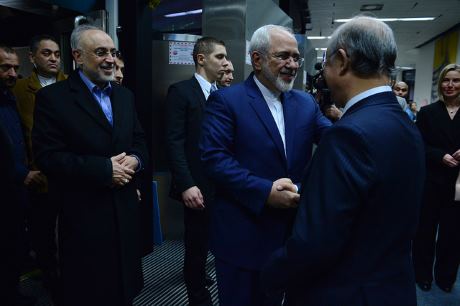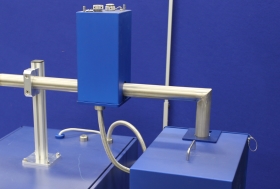Implementation day for JCPOA
18 January 2016
Implementation of the Joint Comprehensive Plan of Action (JCPOA) between Iran and the E3/EU+3 countries has begun after the International Atomic Energy Agency (IAEA) confirmed that Iran had taken all the necessary measures. New technology will play a key role in the IAEA's Iranian monitoring activities.
 |
| Amano greets Salehi and Iranian foreign minister Mohammad Javad Zarif at IAEA headquarters on 16 January. (Image: D Calma/IAEA) |
Implementation followed the 16 January release of a report by IAEA director general Yukiya Amano confirming that Iran had completed the necessary preparatory steps based on verification by IAEA inspectors. The report was submitted to the IAEA Board of Governors and the United Nations Security Council. Implementation of the JCPOA clears the way for the lifting of nuclear-related economic sanctions imposed against Iran.
The JCPOA was signed in July 2015 by Iran and the E3/EU+3 (China, France, Germany, Russia, the UK and the USA - also referred to as the P5+1 - plus the European Union). Under its terms, Iran agreed to limit its uranium enrichment activities, eliminate its stockpile of medium-enriched uranium and limit its stockpile of low enriched uranium over the next 15 years.
Since the JCPOA was adopted in October 2015, Iran has reduced its stockpiles of enriched uranium to agreed levels, including the shipment of 11 tonnes (25,000 pounds) of low-enriched uranium materials from Iran to Russia. Other measures include the removal of numerous centrifuges and related infrastructure from its uranium enrichment plants at Natanz and Fordow, and the removal of the core from the Arak heavy water reactor which has been rendered inoperable by filling openings into the calandria with concrete.
Iran will now start to implement provisionally the Additional Protocol to its IAEA safeguards agreement, which together with other measures under the JCPOA will increase the agency's ability to monitor nuclear activities in Iran and verify that they are peaceful.
Amano congratulated all those who had helped to make implementation of the JCPOA a reality. "We have come a long way since the IAEA first started considering the Iran nuclear issue in 2003," he said.
Speaking in Iran today, Amano said that relations between the IAEA and Iran were now entering a new phase. Amano said that he had agreed with Iranian Vice President Ali Akbar Salehi, chairman of the Atomic Energy Organization of Iran, to further strengthen cooperation between Iran and the IAEA. "We are committed to continuing our work in an impartial, factual and non-political way," he said.
United Nations Secretary General Ban Ki-moon welcomed the implementation as a "significant milestone that reflects the good faith effort by all parties to fulfil their agreed commitments". The United Nations Security Council announced on 17 January it had removed Iran's Bank Sepah and its international subsidiary from a sanctions list following the IAEA's report. Bank Sepah had been under a Security Council-mandated asset freeze since 2007.
Technology 24/7
The IAEA has unveiled a new tool that it is using to monitor uranium enrichment activities at Iran's Natanz plant. The Online Enrichment Monitor (OLEM) was installed at Natanz as part of the preparatory work ahead JCPOA implementation. The sealed equipment measures the characteristics of gaseous uranium hexafluoride flowing through the processing pipes out of the cascades of centrifuges in the enrichment plant, providing round-the-clock monitoring to verify that enrichment levels do not exceed 3.67% as required by the JCPOA.
 |
| OLEM: unobtrusive monitoring (Image: V Fournier/IAEA) |
The autonomous monitoring device is connected to an on-site computer which performs calculations, stores results and encrypts data. All the components, including the computer, are under IAEA seal and are tamper-indicating.
Previous IAEA methods to verify enrichment levels have required samples to be shipped to the agency's laboratories for analysis, taking three weeks or longer. Massimo Aparo, head of the IAEA's Iran Task Force, said that some traditional sampling and analysis will still be performed in conjunction with OLEM. Nevertheless, the continuous measurement provided by the new technology will reduce the amount of sample taking and environmental sampling needed, resulting in greater efficiency and cost savings for the IAEA.
Aparo said that the IAEA had accelerated the development of the real-time monitoring technology in light of the requirements of the JCPOA. The IAEA intends to roll out the monitor to gas centrifuge enrichment plants in other countries.
Researched and written
by World Nuclear News